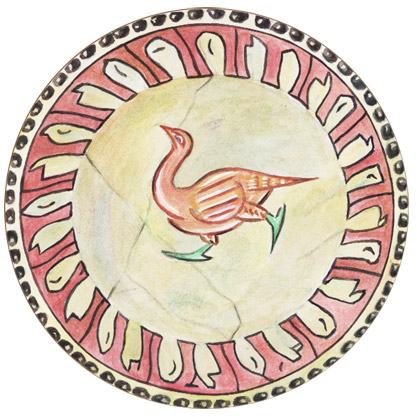The ceramics with animalistic images have a great impor-tance for historical and cultural characteristics of every region, town or settlement of the corresponding epoch. If there is scarcity in materials of folklore, exactly determinate animals can help to reproduce the ancient notions of people about the world and nature.
In the 10th-12th centuries glazed ceramics with vegetable, geometric and epigraphic ornaments were wide-spread in the Chuy valley. Only a few animalistic images are known on Chuy glazed dishes. The running pheasant’s image, situated on a glazed dish of the 11th-12th centuries, is one of them. This dish was discovered by A.N. Bernshtam in 1941 during excavation of the Sokuluk settlement. From that time the glazed dish with the pheasant’s image was published in scien-tific, popular scientific and educational literature [1; 6, c. 68; 4, c. 186]. However, so far this dish was examined solely from an archaeological point of view. In this article I make an attempt to tell about the artistic value of the Chuy valley’s glazed ceramics and to compare the pheasant’s image on the Chuy dish with the portrayals of this bird, located on the glazed dishes from Sogd and Chach.
The pheasant’s figure on the Chuy dish is fulfilled by brown contour and light brown paint. The bird’s feet are painted in bright green colour. The background of the dish is white with a greenish hue (Ill. 1).

Illustration 1. The dish from the Chuy valley.
A medieval artist reproduced the peculiarities of the body’s form, the habits of the pheasant, its typical motions with great reliability and good measure of generalization. The pheasant’s image is an integral part of the ornamental system: the composition and colour range of the animal are connected with the epigraphic ornament and black spots, situated along the dish’s brim.
The epigraphic ornament is a group of stylized Arabic letters, which fulfill, in all probability, solely the decorative function. Gracefully bordering the dish, beautiful light brown letters and black spots, situated slightly higher, complete and sum up all the image.
The dish’s composition stands out for its simplicity and laconism. In spite of the black colour’s presence in the paintings, the colour range of the dish is warm and idle. The technique’s immaculateness, clear and confident drawings, harmony between background and paintings, beautiful combinations of colours testify to the great skill of the artist.
The pheasant’s appearance in the decoration of the Chuy valley’s glazed dish, of course, was not accidental. From old times onwards in Central Asia this animal is considered a sacred bird, a symbol of fire and victory [2, c. 71]. Beginnings of the pheasant’s cult, according to G.V. Grigoriev, a Soviet scientist, was connected with the spreading of Zoroastrianism in Iran and Central Asia. In the Chuy valley the Iranian-speaking settlers from Sogd and Chach confessed Zoroastrianism.
And according to the information of N.Ya. Bichurin, a Russian traveller of the 19th century, we can draw a conclusion that in Central Asia the pheasant could play an important part in an agricultural cult. «There exist a bird, which is like a male pheasant», wrote Bichurin. «When it sits on the palm, a native cuts its belly. If he sees grains inside, crop will be, and if there is sand in the bird’s stomach, crop-failure will be. This is called fortune-telling by bird» [3, c. 132-133].
Besides, with the exception of the Chuy valley the pheasant’s image we can find also on glazed ceramics of Sogd of the 9th-10th centuries and Chach of the 10th-12th centuries [5, табл. XXII; 2, табл. 46,9]. As compared with the realistic portrayals of the pheasant on the Chuy dish, the birds, fulfilled by artists from Sogd and Chach, are conventionalized. It is usual that excessive ornamentalization and geometrism for the birds’ portrayals and by this reason the pheasants have a certain likeness with vegetable and geometrical ornaments. At the same time it is necessary to note that the Sogd and Chuy dishes have one and the same composition: in the centre of the dishes the pheasant’s portrayals is situated, and the brims are decorated with the epigraphic ornament and spots (Ill. 2-3). All of this gives a chance to assert that the Chuy artist, the author of the glazed dish with the pheasant’s image, was under the strong cultural influence of Sogd.

Illustration 2. The dish from Sogd.

Illustration 3. The dish from Chach.
Now the glazed dish with the pheasant’s image is one of the most perfect works of the potter’s trade of the medieval Chuy valley. Centuries later the dish did not lose its artistic quality and it can become a basis for the creation of new works.
1. Бернштам А.Н. Историко-археологические очерки Центрального Тянь-Шаня и Памиро-Алая / МИА № 26. – М.-Л., 1952.
2. Брусенко Л.Г. Глазурованная керамика Чача IX-XII веков. – Ташкент, 1986.
3. Григорьев Г.В. Тус-Тупи. – Искусство, 1937, № 1.
4. История Киргизской ССР, т. I. – Фрунзе, 1968.
5. Майсурадзе З.П. Керамика Афрасиаба. – Тбилиси, 1958.
6. Памятники культуры и искусства Киргизии: древность и средневековье. Каталог выставки. – Л., 1983.